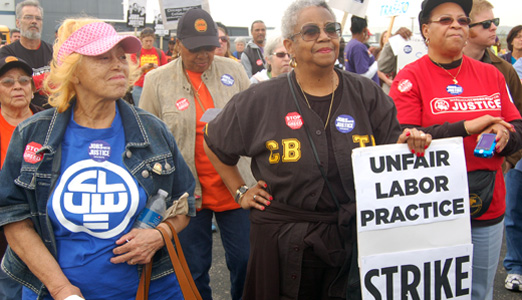
WASHINGTON – Supreme Court justices began hearings yesterday on National Labor Relations Board v. Noel Canning, a case that could determine whether it is legal to stop for months, if not years, the ability of workers to exercise their right to form a union.
Incredibly, the justices spent an entire day asking questions that failed to get to the heart of the matter before them – whether lawmakers can simply take an agency put in place to guarantee the free exercise of union organizing rights and shut that agency down, on one pretext or another.
The case is part of an ongoing war waged by Senate Republicans against not just the Obama Administration and the NLRB but against the basic right of workers to join a union.
Under U.S. Labor Law, the NLRB is the mechanism workers rely on to put in place any decision they make to form a union. There is no way to certify a decision by workers to form a union unless the NLRB is functioning.
Justices spent the day delving into arcane questions of when the Senate is in recess or not and when the President may fill vacancies on the NLRB and elsewhere in government, so government can function.
Since President Obama has been in office Senate Republicans have opposed not only any legislation he has proposed but most appointments he has made to government as well. In that way they have been able to cripple the NLRB for long periods of time. The President, in response, has been forced to make appointments during periods the Senate was in recess, taking advantage of his constitutional authority to appoint without Senate consent if that body was in recess.
The justices quizzed the lawyers about when the president has the power to fill vacancies, both at the NLRB and elsewhere, with “recess appointees”-as Obama did at the labor board-during a three-day Senate recess in January 2012, even if the Senate says it’s not in recess, which it had.
In the case before the Court, the company, its business backers and the Senate GOP argued that if the Senate says it’s not in recess, the president can’t act, ever. The president, of course, has said he can and that he had to make those appointments because GOP filibusters blocked his regular NLRB nominees and brought the board to a halt. (Keep in mind that halting the board means halting implementation of decisions by workers to form unions at their workplaces.)
Interestingly, and inexplicably, Solicitor General Donald Verrilli, speaking for the administration, never even mentioned that problem, avoiding entirely the line of argument that denial of legally protected workers’ rights was the basic issue here.
But because the Senate was still in session between those recesses, with one senator coming in every three days, banging the gavel to open the Senate and then banging it to quit, just a minute later, the recess appointments are illegal, said Noel Francisco, the lawyer for the canning company.
The firm had lost that ridiculous argument at the NLRB when the board had ruled 3-0 in its struggle with Teamsters Local 760 over contract enforcement, but two of the three were “recess appointees.” The firm won in lower courts by saying they were illegal appointees and thus their decision was illegal. Some 1,000 other firms have since used the same defense – all in an attempt to sabotage decisions by workers that they want union representation.
Upholding the firm’s stand “would diminish the president’s authority in a way that is flatly at odds with the constitutional structure the framers established” in 1787, Verrilli told the justices. “There are many hundreds of board decisions that are under a cloud as a result” of the lower court ruling backing the canning company, he added.
“You don’t think we’re going to go back and rip out every decision?” by the NLRB while the recess appointees sat, Justice Stephen Breyer asked. “I certainly hope not,” Verrilli replied.
Verrilli kept making the point that for more than 200 years, presidents made recess appointments when the Senate wasn’t in session and that senators did not challenge them. The practice started to change in the last decade or so, he added, when the Senate started taking short three-day recesses. Justice Antonin Scalia brought him up short.
The company also argued, and the lower court agreed, that recess appointees, and their rulings, are illegal, regardless of whether the recess was three days or longer. Verrilli disputed that, too. “The phrase ‘recess’ encompasses recesses during the session as well as between sessions,” Verrilli stated.
Later, Chief Justice John Roberts pointed out that the Senate could always change its mind and take recesses while still coming in to do business. That would mean the three-day recesses weren’t real recesses, he implied.
“You’re just talking about several significant words that they (the Senate) can change at the drop of a hat,” Roberts said.
“You’re making an assumption that the Senate has to take a recess. They could choose to work every day,” Justice Sonia Sotomayor immediately added, drawing laughter from the packed courtroom.
The justices got Verrilli to admit the Senate could set its own rules, including for legislating – or approving NLRB members-during recesses. But using its rules to limit the president’s power to staff the government is another matter, he said.
“You might give the Senate some deference with requirements that apply internally to Congress. But when it violates the president’s appointments power, it’s another thing,” he told Breyer.
Francisco, the company lawyer, stuck to the basic proposition that the Senate wasn’t in recess, since it was meeting every three days for the one-minute sessions, so the NLRB recess appointments – and others – are illegal.
“Your argument would destroy the recess appointments power,” Justice Ruth Bader Ginsburg told him. “If he (the president) thinks the Senate is being derelict in its duties, he can convene them,” Francisco replied. “The advice and consent power is an important check on the president” and a ruling for the administration would let the president overrule it, he contended.
At least one justice, Breyer, suggested that no matter which way the court rules on the constitutional issue, the NLRB may be able to solve the practical matter of what to do about the 1,000 cases where businesses have challenged its power to rule at all.
The justice noted the High Court ruled before, also upholding a lower court decision by pro-GOP judges, that the NLRB lacked a quorum to decide cases. The board later went through all those cases and re-ruled on them, he said. It could easily do so again, “but it would just mean more work” for the board, Breyer added.
The justices will rule on the case by the end of June.
Photo: Peoplesworld.org











